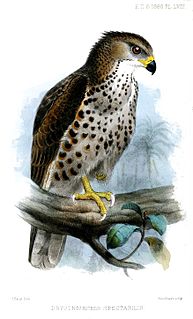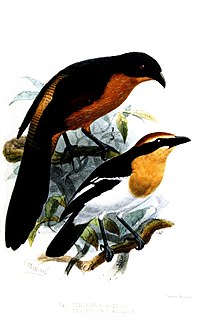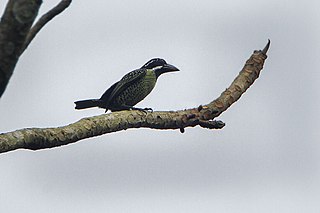
The African paradise flycatcher is a medium-sized passerine bird. The two central tail feathers of the male are extended into streamers that commonly are more than twice as long as the body. The female tail feathers are of moderate length and without streamers. The upper parts of the male body, wings, and tail are boldly coloured in chestnut or rusty shades, but the underparts and the head are variably grey to blue-gray, with the head of the mature male being darker, commonly glossy black with greenish highlights. The beak and other bare areas, including a wattle ring round the eye, match the colour of the surrounding feathers. The female coloration is similar, though not so showy and glossy and with the head paler.

The red-bellied paradise flycatcher, also known as the black-headed paradise flycatcher, is a medium-sized passerine bird of the family of monarch flycatchers. It is native to intra-tropical forests of Africa. The male bird is about 17 cm (7 in) long and has a black head, a mainly chestnut body, and a tail with streamers nearly twice as long as the body. The colouring is somewhat variable across the bird's range. Both females and juveniles lack the tail streamers and are a duller brown colour. It is closely related to the African paradise flycatcher, and the two can hybridise.

The Indian paradise flycatcher is a medium-sized passerine bird native to Asia, where it is widely distributed. As the global population is considered stable, it has been listed as Least Concern on the IUCN Red List since 2004. It is native to the Indian subcontinent, Central Asia and Myanmar.

The paradise flycatchers (Terpsiphone) are a genus of birds in the family Monarchidae. The genus ranges across Africa and Asia, as well as a number of islands. A few species are migratory, but the majority are resident. The most telling characteristic of the genus is the long tail streamers of the males of many species. In addition to the long tails the males and females are sexually dimorphic and have rufous, black and white plumage.

The Seychelles paradise flycatcher is a rare bird from the genus of paradise flycatchers (Terpsiphone) within the family Monarchidae. It is a forest-dwelling bird endemic to the Seychelles where it is native to the island of La Digue. Males have glossy black plumage with elongated tail feathers, while females are reddish-brown with pale underparts and no long tail feathers. The International Union for Conservation of Nature lists this bird as being "Vulnerable" and attempts have been made to increase its numbers by relocating some individuals to Denis Island, another island in the Seychelles archipelago.

The sandy scops owl, or cinnamon scops owl, is an owl from the family Strigidae found in Africa.

The red-thighed sparrowhawk, alternatively known as the red-legged sparrowhawk or the western little sparrowhawk is a species of sparrowhawk in the family Accipitridae from western and northern central Africa.

The Congo serpent eagle is a species of bird of prey in the family Accipitridae, and is sometimes placed in the monotypic genus Dryotriorchis by some taxonomic authorities. This species is distributed across the African tropical rainforest, including upper and lower Guinean forests. This serpent eagle specializes in hunting in these forests’ dark understories. It has two subspecies, the nominate subspecies Dryotriorchis spectabilis spectabilis and Dryotriorchis spectabilis batesi. Though monotypic, it appears to be very closely related to Circaetus. This hawk is a medium-sized bird with distinctive short, rounded wings and a long, rounded tail. It is varying shades of brown on its back and has a slight crest. Its breast is white with variable amounts of a rufous wash and, in the nominate subspecies, is covered in round, blackish spots. The subspecies D. s. batesi only has these dots on its flanks. The Congo serpent eagle closely resembles Cassin's hawk-eagle, and some ornithologists believe that this likeness is a rare example of avian mimicry. It is a very vocal raptor, and often is one of the most heard species in its habitat.

Bates's nightjar or the forest nightjar, is a bird species of the family Caprimulgidae, found in the rainforests of western Sub-Saharan Africa.

The Gabon coucal is a species of cuckoo in the family Cuculidae. It is mainly found in Gabon but also occurs in neighboring areas of Cameroon, Angola, the Central African Republic, the western Congo Basin and Equatorial Guinea.

The slender-billed greenbul is a species in the monotypic genus Stelgidillas of the bulbul family of passerine birds. It is found in western and central Africa. Its natural habitats are subtropical or tropical dry forest, subtropical or tropical moist lowland forest, and subtropical or tropical moist montane forest.

The rufous-tailed palm thrush is a species of bird in the family Muscicapidae.
The white-headed robin-chat is a species of bird in the family Muscicapidae. It is found in northern Angola and the western Democratic Republic of the Congo. It is threatened by habitat loss, and its IUCN conservation status is vulnerable.

The white-browed robin-chat, also known as Heuglin's robin, is a species of bird in the family Muscicapidae. Found in east, central and southern Africa, its natural habitats include riverine forest and thickets, and it is also found near humans. The IUCN classifies it as a least-concern species.

Fraser's rufous thrush, also known as the rufous flycatcher-thrush, is a species of bird in the thrush family.

The rufous paradise flycatcher is a species of bird in the family Monarchidae. It is found in Indonesia and the Philippines. Its natural habitat is subtropical or tropical moist lowland forests.

The rufous-vented paradise flycatcher is a species of bird in the family Monarchidae. It is found from southern Cameroon to eastern and central Democratic Republic of the Congo and north-western Angola. This species readily hybridizes with the genetically similar African paradise flycatcher. Its natural habitats are subtropical or tropical swamps and shrub-dominated wetlands.

The blue-headed crested flycatcher is a species of bird in the family Monarchidae, native to the African tropical forest.

The hairy-breasted barbet is a species of bird in the family Lybiidae. It is found throughout the Africa tropical rainforest.
The rufous-bellied helmetshrike or Gabon helmetshrike is a passerine bird belonging to the Vanga family, Vangidae. It inhabits tropical forest in Central Africa. It is sometimes included within the chestnut-bellied helmetshrike of West Africa.



















